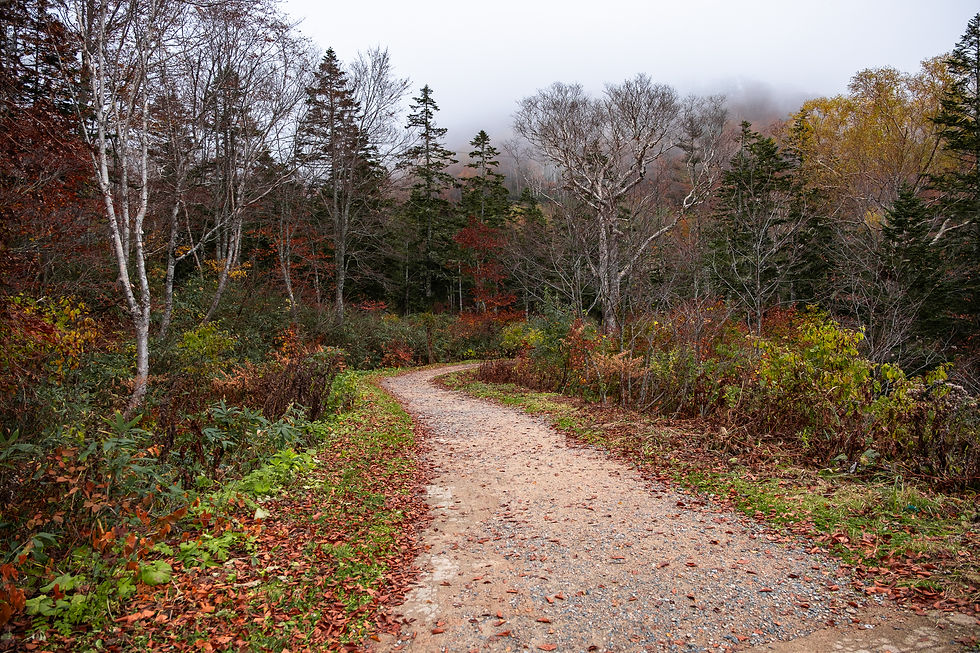Hakuba area in the Japanese Alps
- Nimrod

- Jul 18
- 6 min read
Updated: Aug 14
October 2024 [To all posts in Japan]

Content
Hakuba Area in the Japanese Alps – Introduction
After leaving Kanazawa, we made our way to Hakuba Area in the Japanese Alps—a long day on the road with our rental car, made even longer when the road from Shirakawa-go to Takayama was unexpectedly closed.
The Japanese Alps are divided into several ranges, and Hakuba sits in the Northern Alps. It’s a stunning area, perfect for mountain lovers.
We settled in for two nights at The Happo Hotel in Hakuba. It’s a charming spot with a relaxing public onsen (separate for men and women) and a surprisingly good breakfast. There’s even an Italian restaurant and a cozy pub attached to the property—perfect after a day outdoors.
I’m adding a map for reference, marking the spots we explored:
On the right, a cluster of beautiful shrines.
On the left, the nature reserve with its scenic ropeway stations.
Hakuba is a charming ski town famous for its hot springs, and it even hosted ski jumping and cross-country events during the 1998 Winter Olympics in Japan.
But guess what? It’s not just a winter destination! From late June through the end of October, the mountains turn into a summer playground. Several gondolas and lifts operate during this season, making it easy to access stunning viewpoints and alpine trails.
You can go for short day hikes like we did—or set off on longer 2–3 day treks if you’re feeling adventurous.
Breaking It Down by Days
Day 1 – A shrine-hopping hike along the Togakushi Trail
Day 2 – Exploring the stunning Tsugaike Nature Reserve
More Trips in Japan
Day 1 – Hiking the Togakushi Shrine Trail
Today we visited three shrines that together make a perfect day trip. It’s possible to walk between them along one continuous trail, starting from the lower shrine or the upper one—the total distance is about 10 km.

The shrines are connected to an important story in Japanese mythology. According to legend, the Sun Goddess hid herself in a cave in what is now Takachiho on the island of Kyushu after her brother behaved in a disrespectful way, plunging the world into darkness.
To bring back sunlight, the other goddesses tried to lure her out by performing spectacular dances outside the cave. When the Sun Goddess peeked out, one of the goddesses grabbed the stone door and threw it away to keep her from hiding again.
That stone door is said to have flown all the way to Togakushi in Nagano Prefecture—and that’s how the area got its name: “Togakushi” literally means “Hidden Door.

We decided to mix hiking with short drives. We started by driving to the Upper Shrine (Okusha), then drove to the Lower Shrine (Hokosha). From there, we hiked to the Middle Shrine (Chusha) and finally returned to the parking lot near the Lower Shrine.

All the shrines are located along the same road, and there’s also a bus line connecting them, so you can plan whatever works best for you.
We drove to the parking area for the Upper Shrine (Togakushi Shrine Okusha). From the lot, it’s about a 2 km walk along a beautiful path to reach the Upper Shrine complex.

Along the way, you walk along a wide path lined with shrubs and trees in full autumn colors. Even the cars parked nearby seem to blend perfectly with the fall palette.


After passing through this charming gate with greenery growing on its roof, you arrive at an impressive cedar-lined avenue, where towering trees have stood for hundreds of years. The place was full of bird photographers waiting patiently with massive lenses to capture the shot of a lifetime.
There’s also a botanical garden here, along with plenty of side trails branching off from the main path to the shrine.


After that, we drove back to the lowest shrine, Hokosha, where a steep climb of about 200 steps awaits you.


From the lower shrine, we walked about 2 km (around 35 minutes) to the middle shrine (Chusha), which also requires a climb up a steep set of stairs.


We headed back down to the lower shrine, picked up the car, and drove back to the hotel.
Each approach to the shrines had its own charm, and visiting them in autumn was absolutely worth it. Along the way, we noticed plenty of bear warning signs (not that there’s much you can do about that). The Japanese carry little bells on their hikes—it’s adorable, so of course we got some too. I kept wondering, do the bears know about this bell arrangement?

Everything felt calm, orderly, and serene (which, as we later realized, is pretty much Japan in a nutshell). It’s not like back home, where any recipe for a complicated dish starts with: “First, calm down.” :)
We wrapped up the day with a dip in the hotel onsen—pure bliss. Just you, the steaming water, and a few quiet moments to let your thoughts float away.
The area is full of Aussies who come to work and study here. Most hotels open during ski season (December to April), and only a few stay open in autumn.
What’s your pick?
On the right—soba noodles and tempura at a small restaurant by the upper shrine’s parking lot; on the left—our hearty breakfast at The Happo Hotel.
How to Get There by Car
Parking for the upper shrine is available here, and you can easily drive to each of the three shrines and park nearby.
Getting There by Public Transport
There’s a bus (Route No. 70) that runs from Nagano City and stops at all three shrines, with departures roughly once an hour.
(You can also find detailed info in the Japan guide)
Day Two – Hiking in Tsugaike Nature Park

We set out in the morning for Tsugaike Nature Park, a beautiful reserve near Hakuba (official site here).
This gorgeous park offers a scenic 5 km walking route, mostly along wooden boardwalks. If you’re lucky and the weather plays along, you’ll be rewarded with incredible views.

Tip: Check the availability of the ropeways before your visit—they’re essential for reaching the park. The trails are usually open from early June to early November.
We visited in late October, just as autumn colors were peaking. The morning started cloudy and misty, but as we rode the gondolas up, we climbed above the fog—and suddenly, blue skies opened up.

To reach the park, you’ll need to take two ropeways. The first one—where you’ll also find parking—is a small enclosed gondola that takes about 15 minutes to reach a higher station. From there, hop on a large cable car for another 5-minute ride, which brings you right to the entrance of the nature park.


The round-trip cable car ride plus park entry costs ¥3,700 per person (you can check details on the official website).
Inside the park, there’s a scenic loop trail that I mentioned earlier. You can hike it clockwise or counterclockwise—we went counterclockwise, simply taking every left turn at the junctions. At the park office, you’ll also get a handy map to guide your way.


There’s a restaurant, an ice cream stand, and a visitor center right at the park entrance. If you’re hiking on a chilly day, be sure to dress warmly—think wool hat and gloves.
The loop trail is simply beautiful, and at its highest point, you’re rewarded with stunning views of the mountains, vibrant fall foliage, and clouds drifting by.


Getting There by Car: The parking lot for the first gondola is right here — this is where you start your ride up the mountain.
Getting There by Public Transport: For detailed info on how to get there by bus or train, check out the Japanese Alps website — it’s super thorough.
More Trip Options in the Area
Happo Pond (Lake Happo)

The lake is located here, about 10 km from Hakuba by car, then a cable car ride, or you can reach it using two cable cars (for more details, check the site here).
The lake area is open for hiking from early July until the end of October.
The walk to the lake is family-friendly and takes about an hour to an hour and a half.
How to get there by car
You can park at the Kurobishi parking lot here and then take one or two cable cars up to the lake. Keep in mind — if the parking lot is full, you won’t be able to continue, so it’s best to arrive early.
Here’s a great map showing the roads and cable car routes.
Longer hikes starting from the entrance of Tsugaike Nature Park
One great half-day hike is called ״Tenguhara״ — you can find details here and also here. The trailhead starts right at the park entrance (you need to register at the park office).
The round-trip distance is about 3 km, with a total ascent of 340 meters. It takes roughly two hours each way.
You can hike this trail from June through October — but be sure to check in advance if it’s open and to register.
There are also longer hikes in the area that include overnight stays in mountain huts — more info here.
Snow Monkey Park (Jigokudani Yaen-Koen)
Definitely worth a visit in winter, but you can come anytime (location here)
Here are some photos of a lake we stumbled upon on the way out of the area heading toward Kamikochi:




































Comments